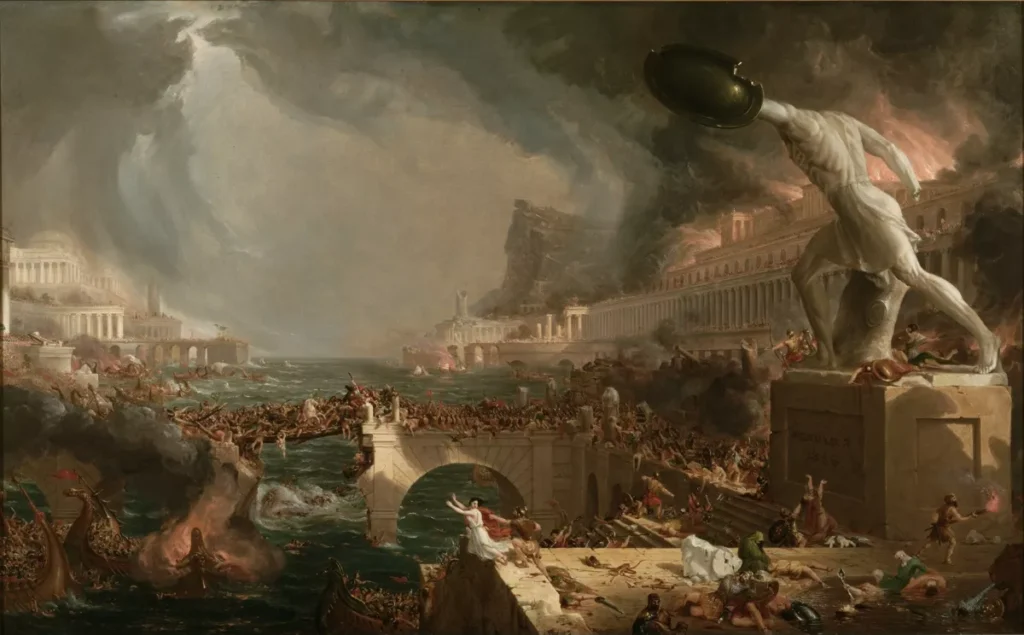The Worst Year in History to Be Alive
Teaser: It does not fall between 2020-2023

^ New Yorkers out vaping while on a Starbucks run during the recent Smog-pocolypse
A few weeks ago as I ascended out of the depths of the West 4th Street station, I found myself exiting onto a 6th Avenue that resembled the set of Blade Runner, a scene enveloped by a warm orange glow and weighed down by a heavy vignette of thick haze. For 48 hours, New York looked like the backdrop of a Mexican cartel movie and we helplessly were hurled through the Covid Looking Glass, where instead of putting on masks to go into establishments and taking them off when exiting, we found ourselves doing the exact opposite, all while being severely emotionally triggered by officials issuing foreboding public statements recommending masks for compromised individuals while not fully addressing the threat at hand.
Now that we’ve had a moment to enjoy prolonged normalcy, we can peer in the rearview mirror at the not-so-distant purgatory that was 2020 and 2021 and make a seemingly justifiable claim that it was the worst time to be alive in the history of the world. A bit short sighted when you think about 1347 when the Black Death wiped out the majority of Europe, or the 1490s when smallpox decimated the indigenous populations of America, or that time a no-name Archduke was assassinated, shepherding in two global conflicts and history’s most horrific genocide.
Yes, I know we are currently being forced to live through the pain of the Sex in the City reboot, but put down that therapy Juul and buckle up for what historians unanimously declare was the worst time to be alive in the annals of mankind: 536 AD.

Imagine, in a time before social media, general news, and far-reaching communication, all of a sudden, an ominous cloud of black ash rolls across the sky, blocking out the sun and doesn’t lift for well over a year. Well that was the spooky reality of life in 536 AD, as the world slipped into a darkness that blocked out the sun for a full 18 months. At the same time, an outbreak of the bubonic plague coincided with a piercing cold snap that sent the entire globe into crop failure, starvation, and squalor. The year was a tipping point in an era of unprecedented devastation, the beginning of one of the worst periods to be alive. The literal Dark Ages. So what happened?
A massive volcanic eruption in Iceland in 536 ushered in an ash-filled fog, that blanketed the globe, prompted rigid temperatures, blighted crops, eroded seasons, and wrecked economies. The Byzantine historian Procopius wrote, “the sun gave forth its light without brightness, like the moon, during this whole year…men were free neither from war nor pestilence, nor any other thing leading to death.” Two more eruptions in the years 540 and 547 would further compound the ash plum, prolonging this living hell and sparking the coldest decade in 2,500 years, possibly since the last ice cage. The Late Antique Little Ice Age that began in the spring of 536 lasted in western Europe until about 660, and it lasted until about 680 in Central Asia.
To add insult to injury for those who survived the never ending darkness, in 541 an outbreak of the Bubonic Plague tore through the Mediterranean, killing 100 million people. This accounted up to one-half of the population in the Byzantine Empire, squashing any remaining economic pulse. The Roman empire wasn’t the lone victim here; a group known as the Avars in Eastern Europe disappeared, the Great Migration Period in Europe screeched to a halt, the Gupta Empire in India collapsed, the Sasanian Empire in modern-day Iran ended, the Teotihuacan civilization vanished, and the Mongols and Turkic peoples began mass migrations west.
Ironically, historians believe the pollutants sparked the European economy’s revival, pulling it out of the deep and depressing chasm around 100 years later. Lead was crucial in the production of silver, which eventually spurred an economic resurgence as the sky cleared and the pestilence waned. This is supported by evidence of total economic transformation between 640 and 660.
So next time you find yourself questioning the direction society is headed after spending 20 minutes sucked into any “recommended for you” content regurgitated by the algorithm, humble yourself by remembering that you could have been alive during the hellscape of 536 instead.